Economic Globalization Impacts on the Ecological Environment of Inland Developing Countries: A Case Study of Laos from the Perspective of the Land Use/Cover Change
Abstract
1. Introduction
2. Study Area and Data Source
2.1. Study Area
2.2. Data Source
3. Methods
- (1)
- Number of patches (NP).
- (2)
- Mean patch size (MPS).
- (3)
- Landscape shape index (LSI).
- (4)
- Contagion index (CONT).
4. Results
4.1. Analysis of Land Use/Cover Change
4.2. Analysis of Landscape Pattern Change
4.3. Topographic Analysis of Changed Area
5. Discussion
6. Conclusions
Author Contributions
Funding
Acknowledgments
Conflicts of Interest
References
- Polasky, S.; Nelson, E.; Camm, J.; Csuti, B.; Fackler, P.; Lonsdorf, E.; Montgomery, C.; White, D.; Arthur, J.; Garber-Yonts, B.; et al. Where to put things? Spatial land management to sustain biodiversity and economic returns. Biol. Conserv. 2008, 141, 1505–1524. [Google Scholar] [CrossRef]
- Ge, D.Z.; Long, H.L.; Zhang, Y.G.; Ma, L.; Li, T.T. Farmland transition and its influences on grain production in China. Land Use Policy 2018, 70, 94–105. [Google Scholar] [CrossRef]
- Ge, D.; Wang, Z.; Tu, S.; Long, H.; Yan, H.; Sun, D.; Qiao, W. Coupling analysis of greenhouse-led farmland transition and rural transformation development in China’s traditional farming area: A case of Qingzhou City. Land Use Policy 2019, 86, 113–125. [Google Scholar] [CrossRef]
- Nahuelhual, L.; Carmona, A.; Lozada, P.; Jaramillo, A.; Aguayo, M. Mapping recreation and ecotourism as a cultural ecosystem service: An application at the local level in Southern Chile. Appl. Geogr. 2013, 40, 71–82. [Google Scholar] [CrossRef]
- Balthazar, V.; Vanacker, V.; Molina, A.; Lambin, E.F. Impacts of forest cover change on ecosystem services in high Andean mountains. Ecol. Indic. 2015, 48, 63–75. [Google Scholar] [CrossRef]
- Cabral, A.I.R.; Costa, F.L. Land cover changes and landscape pattern dynamics in Senegal and Guinea Bissau borderland. Appl. Geogr. 2017, 82, 115–128. [Google Scholar] [CrossRef]
- Hao, R.F.; Yu, D.Y.; Liu, Y.P.; Liu, Y.; Qiao, J.M.; Wang, X.; Du, J.S. Impacts of changes in climate and landscape pattern on ecosystem services. Sci. Total Environ. 2017, 579, 718–728. [Google Scholar] [CrossRef]
- Arowolo, A.O.; Deng, X.Z.; Olatunji, O.A.; Obayelu, A.E. Assessing changes in the value of ecosystem services in response to land-use/land-cover dynamics in Nigeria. Sci. Total Environ. 2018, 636, 597–609. [Google Scholar] [CrossRef]
- Polasky, S.; Nelson, E.; Pennington, D.; Johnson, K.A. The Impact of Land-Use Change on Ecosystem Services, Biodiversity and Returns to Landowners: A Case Study in the State of Minnesota. Environ. Resour. Econ. 2011, 48, 219–242. [Google Scholar] [CrossRef]
- Kellenberg, D. Trading wastes. J. Environ. Econ. Manag. 2012, 64, 68–87. [Google Scholar] [CrossRef]
- Furumo, P.R.; Aide, T.M. Characterizing commercial oil palm expansion in Latin America: Land use change and trade. Environ. Res. Lett. 2017, 12, 024008. [Google Scholar] [CrossRef]
- Chen, Q.; Li, Y.C.; Liu, C.X.; Yang, Y.N.; Wu, J.; Li, M.Y. Spatio-Temporal Variation in Mountainous Landscape Changes: A Case Study of Shizhu County. Sustainability 2019, 11, 2131. [Google Scholar] [CrossRef]
- Dadashpoor, H.; Azizi, P.; Moghadasi, M. Land use change, urbanization, and change in landscape pattern in a metropolitan area. Sci. Total Environ. 2019, 655, 707–719. [Google Scholar] [CrossRef]
- Krajewski, P. Monitoring of Landscape Transformations within Landscape Parks in Poland in the 21st Century. Sustainability 2019, 11, 2410. [Google Scholar] [CrossRef]
- Li, Z.; Liu, W.Z.; Zhang, X.C.; Zheng, F.L. Impacts of land use change and climate variability on hydrology in an agricultural catchment on the Loess Plateau of China. J. Hydrol. 2009, 377, 35–42. [Google Scholar] [CrossRef]
- Veijalainen, N.; Dubrovin, T.; Marttunen, M.; Vehvilainen, B. Climate Change Impacts on Water Resources and Lake Regulation in the Vuoksi Watershed in Finland. Water Resour. Manag. 2010, 24, 3437–3459. [Google Scholar] [CrossRef]
- Wenbin, W.U.; Peng, Y.; Huajun, T.; Luca, O.; Ryosuke, S. Regional Variability of Effects of Land Use System on Soil Properties. Sci. Agric. Sin. 2007, 40, 1697–1702. [Google Scholar]
- Zhang, S.H.; Li, Y.Q.; Fan, W.W.; Yi, Y.J. Impacts of Rainfall, Soil Type, and Land- Use Change on Soil Erosion in the Liusha River Watershed. J. Hydrol. Eng. 2017, 22, 11. [Google Scholar] [CrossRef]
- Serpa, D.; Nunes, J.P.; Keizer, J.J.; Abrantes, N. Impacts of climate and land use changes on the water quality of a small Mediterranean catchment with intensive viticulture. Environ. Pollut. 2017, 224, 454–465. [Google Scholar] [CrossRef]
- Meffert, P.J.; Dziock, F. The influence of urbanisation on diversity and trait composition of birds. Landsc. Ecol. 2013, 28, 943–957. [Google Scholar] [CrossRef]
- Seppelt, R.; Lautenbach, S.; Volk, M. Identifying trade-offs between ecosystem services, land use, and biodiversity: A plea for combining scenario analysis and optimization on different spatial scales. Curr. Opin. Environ. Sustain. 2013, 5, 458–463. [Google Scholar] [CrossRef]
- Wang, X.C.; Dong, X.B.; Liu, H.M.; Wei, H.J.; Fan, W.G.; Lu, N.C.; Xu, Z.H.; Ren, J.H.; Xing, K.X. Linking land use change, ecosystem services and human well-being: A case study of the Manas River Basin of Xinjiang, China. Ecosyst. Serv. 2017, 27, 113–123. [Google Scholar] [CrossRef]
- Hostert, P.; Kuemmerle, T.; Prishchepov, A.; Sieber, A.; Lambin, E.F.; Radeloff, V.C. Rapid land use change after socio-economic disturbances: The collapse of the Soviet Union versus Chernobyl. Environ. Res. Lett. 2011, 6, 045201. [Google Scholar] [CrossRef]
- Rutten, M.; van Dijk, M.; van Rooij, W.; Hilderink, H. Land Use Dynamics, Climate Change, and Food Security in Vietnam: A Global-to-local Modeling Approach. World Dev. 2014, 59, 29–46. [Google Scholar] [CrossRef]
- Yamamoto, Y.; Shigetomi, Y.; Ishimura, Y.; Hattori, M. Forest change and agricultural productivity: Evidence from Indonesia. World Dev. 2019, 114, 196–207. [Google Scholar] [CrossRef]
- Paudyal, K.; Baral, H.; Bhandari, S.P.; Bhandari, A.; Keenan, R.J. Spatial assessment of the impact of land use and land cover change on supply of ecosystem services in Phewa watershed, Nepal. Ecosyst. Serv. 2019, 36, 100895. [Google Scholar] [CrossRef]
- Meyfroidt, P.; Lambin, E.F.; Erb, K.H.; Hertel, T.W. Globalization of land use: Distant drivers of land change and geographic displacement of land use. Curr. Opin. Environ. Sustain. 2013, 5, 438–444. [Google Scholar] [CrossRef]
- Destek, M.A. Investigation on the role of economic, social, and political globalization on environment: Evidence from CEECs. Environ. Sci. Pollut. Res. 2019, 1–14. [Google Scholar] [CrossRef]
- Vilaihong, M.; UN. Status of Geological Mapping and Mineral Resource Assessment and Development in the Lao People’s Democratic Republic; Economic and Social Commission for Asia and the Pacific, United Nations: Bangkok, Thailand, 2000; Volume 11, pp. 163–209. [Google Scholar]
- Watcharejyothin, M.; Shrestha, R.M. Effects of cross-border power trade between Laos and Thailand: Energy security and environmental implications. Energy Policy 2009, 37, 1782–1792. [Google Scholar] [CrossRef]
- Xiong, Y.S. Opportunities and Challenges Laos Facing after Joining into WTO. Around Southeast Asia 2013, 8, 41–45. [Google Scholar]
- World Bank. World Bank Open Data. Available online: https://data.worldbank.org.cn (accessed on 15 February 2019).
- Kokmila, K.; Lee, W.K.; Badarch, O.; Kim, S.R.; Choi, S.; Park, S. Mapping Forest Functions Using GIS at Plateau Area, Laos. For. Sci. Technol. 2009, 5, 57–61. [Google Scholar] [CrossRef]
- Hewanma, Z.; Wu, C. Analysis of Forest cover change and its driving Force in Laos. Geogr. Res. 2009, 28, 391–401. [Google Scholar]
- Fujisaka, S. A diagnostic survey of shifting cultivation in Northern Laos—Targeting research to improve sustainability and productivity. Agrofor. Syst. 1991, 13, 95–109. [Google Scholar] [CrossRef]
- Sandewall, M.; Ohlsson, B.; Sawathvong, S. Assessment of Historical Land-Use Changes for Purposes of Strategic Planning—A Case Study in Laos. Ambio-J. Hum. Environ. 2001, 30, 55–61. [Google Scholar] [CrossRef]
- Grekousis, G.; Mountrakis, G.; Kavouras, M. An overview of 21 global and 43 regional land-cover mapping products. Int. J. Remote Sens. 2015, 36, 5309–5335. [Google Scholar] [CrossRef]
- Hansen, M.C.; Reed, B. A comparison of the IGBP DISCover and University of Maryland 1 km global land cover products. Int. J. Remote Sens. 2000, 21, 1365–1373. [Google Scholar] [CrossRef]
- Bartholome, E.; Belward, A.S. GLC2000: A new approach to global land cover mapping from Earth observation data. Int. J. Remote Sens. 2005, 26, 1959–1977. [Google Scholar] [CrossRef]
- Friedl, M.A.; Sulla-Menashe, D.; Tan, B.; Schneider, A.; Ramankutty, N.; Sibley, A.; Huang, X.M. MODIS Collection 5 global land cover: Algorithm refinements and characterization of new datasets. Remote Sens. Environ. 2010, 114, 168–182. [Google Scholar] [CrossRef]
- Arino, O.; Gross, D.; Ranera, F.; Leroy, M.; Bicheron, P.; Brockman, C.; Defourny, P.; Vancutsem, C.; Achard, F.; Durieux, L.; et al. GlobCover ESA service for Global land cover from MERIS. In Proceedings of the 2007 IEEE International Geoscience and Remote Sensing Symposium, Barcelona, Spain, 23–27 July 2007; Volume 1–12, pp. 2412–2415. [Google Scholar]
- Defourny, P.; Schouten, L.; Bartalev, S.; Bontemps, S.; Caccetta, P.; Hazeu, G.W.; Bella, C.D.; Gerard, B.; Giri, C.; Gonf, V.; et al. Accuracy assessment of a 300 m global land cover map: The GlobCover experience. New Libr. World 2009, 112, 236–247. [Google Scholar]
- Chen, J.; Chen, J.; Liao, A.P.; Cao, X.; Chen, L.J.; Chen, X.H.; He, C.Y.; Han, G.; Peng, S.; Lu, M.; et al. Global land cover mapping at 30 m resolution: A POK-based operational approach. ISPRS J. Photogramm. Remote Sens. 2015, 103, 7–27. [Google Scholar] [CrossRef]
- Gong, P.; Wang, J.; Yu, L.; Zhao, Y.C.; Zhao, Y.Y.; Liang, L.; Niu, Z.G.; Huang, X.M.; Fu, H.H.; Liu, S.; et al. Finer resolution observation and monitoring of global land cover: First mapping results with Landsat TM and ETM+ data. Int. J. Remote Sens. 2013, 34, 2607–2654. [Google Scholar] [CrossRef]
- Lu, C.; Yang, X.M.; Wang, Z.H.; Li, Z. Using multi-level fusion of local features for land-use scene classification with high spatial resolution images in urban coastal zones. Int. J. Appl. Earth Obs. Geoinf. 2018, 70, 1–12. [Google Scholar] [CrossRef]
- Wang, Z.H.; Lu, C.; Yang, X.M. Exponentially sampling scale parameters for the efficient segmentation of remote-sensing images. Int. J. Remote Sens. 2018, 39, 1628–1654. [Google Scholar] [CrossRef]
- Wang, Z.; Yang, X.; Lu, C.; Yang, F. A scale self-adapting segmentation approach and knowledge transfer for automatically updating land use/cover change databases using high spatial resolution images. Int. J. Appl. Earth Obs. Geoinf. 2018, 69, 88–98. [Google Scholar] [CrossRef]
- Kang, J.; Sui, L.; Yang, X.; Wang, Z.; Huang, C. Spatial Pattern Consistency among Different Remote-Sensing Land Cover Datasets: A Case Study in Northern Laos. ISPRS Int. J. Geo-Inf. 2019, 8, 201. [Google Scholar] [CrossRef]
- Liu, F.; Qin, T.L.; Girma, A.; Wang, H.; Weng, B.S.; Yu, Z.L.; Wang, Z.L. Dynamics of Land-Use and Vegetation Change Using NDVI and Transfer Matrix: A Case Study of the Huaihe River Basin. Pol. J. Environ. Stud. 2019, 28, 213–223. [Google Scholar] [CrossRef]
- Wu, J. Landscape Ecology Pattern, Process, Scale and Hierarchy; Higher Education Press: Beijing, China, 2007. [Google Scholar]
- Mao, P. Land Use Change and Its Comprehensive Ecological Effect of Savannakhet in Lao PDR; WuHan University: Wuhan, China, 2017. [Google Scholar]
- Ottinger, M.; Clauss, K.; Kuenzer, C. Aquaculture: Relevance, distribution, impacts and spatial assessments—A review. Ocean Coast. Manag. 2016, 119, 244–266. [Google Scholar] [CrossRef]
- Steele, M.K.; Heffernan, J.B. Morphological characteristics of urban water bodies: Mechanisms of change and implications for ecosystem function. Ecol. Appl. 2014, 24, 1070–1084. [Google Scholar] [CrossRef]
- Zhong, C.; Hao, L. Dilemmas of hydropower development in Laos. Energy Sources Part B 2017, 12, 570–575. [Google Scholar] [CrossRef]
- Yuan, L.; He, W.J.; Liao, Z.Y.; Degefu, D.M.; An, M.; Zhang, Z.F.; Wu, X. Allocating Water in the Mekong River Basin during the Dry Season. Water 2019, 11, 17. [Google Scholar] [CrossRef]
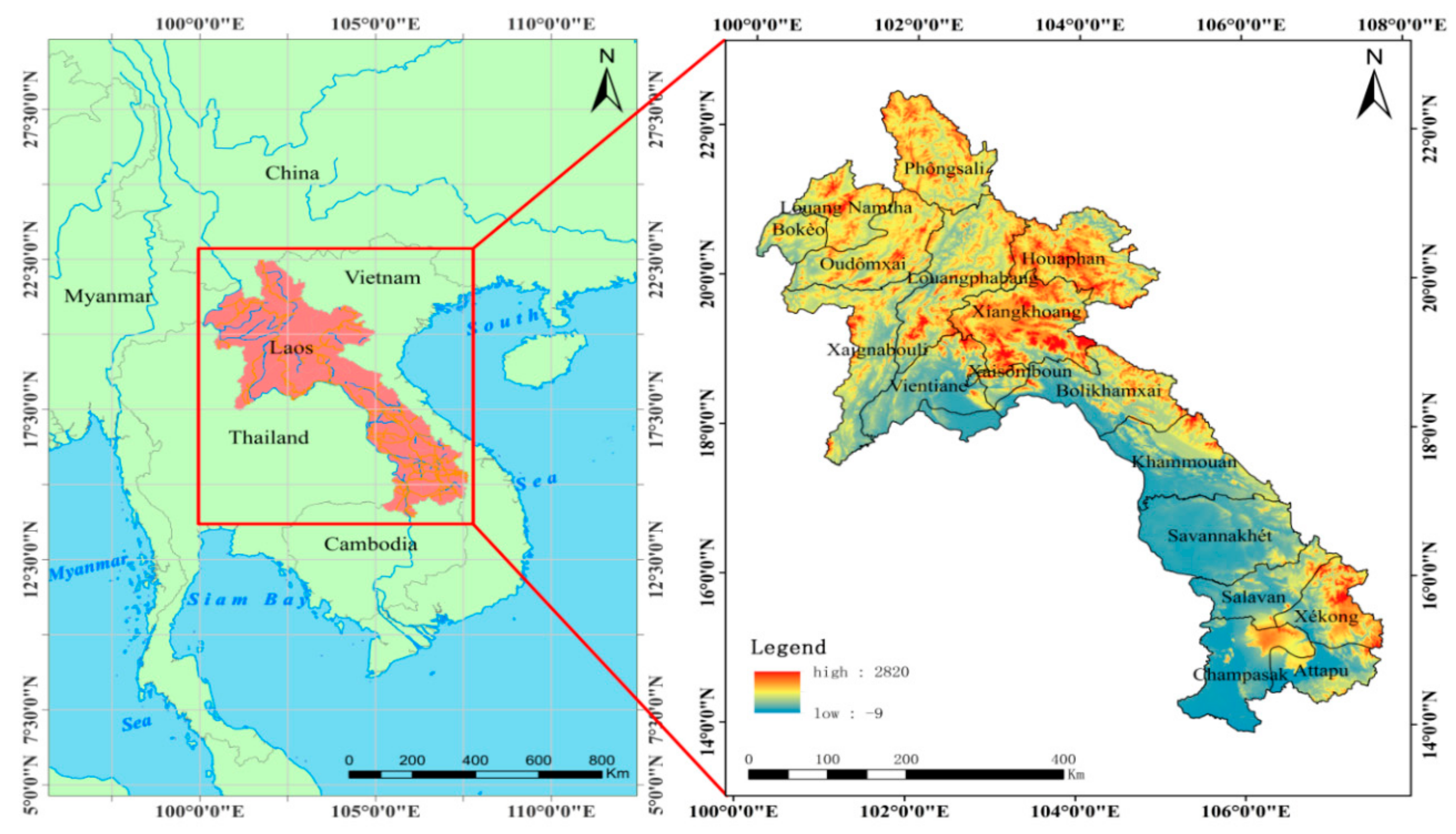
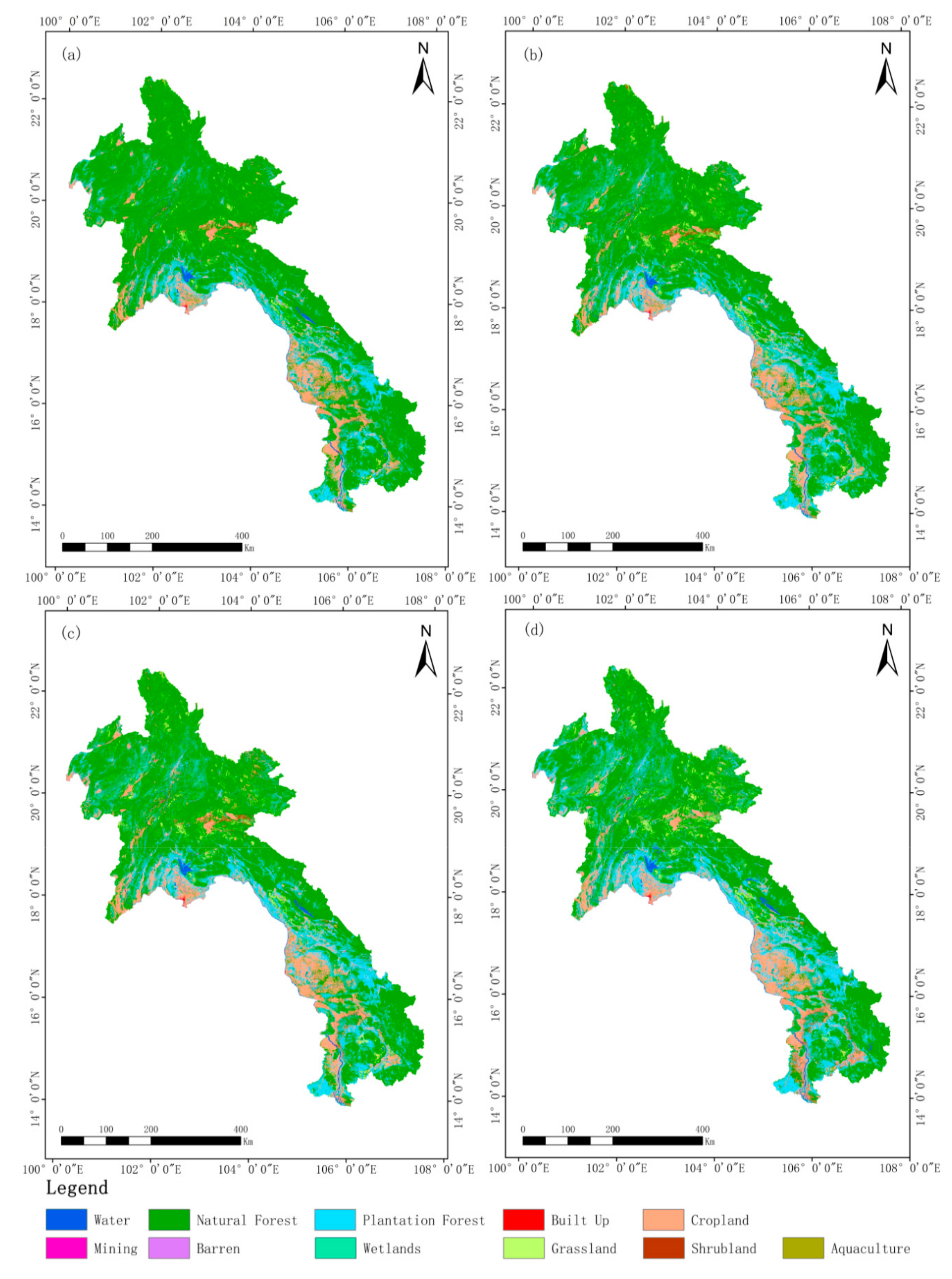
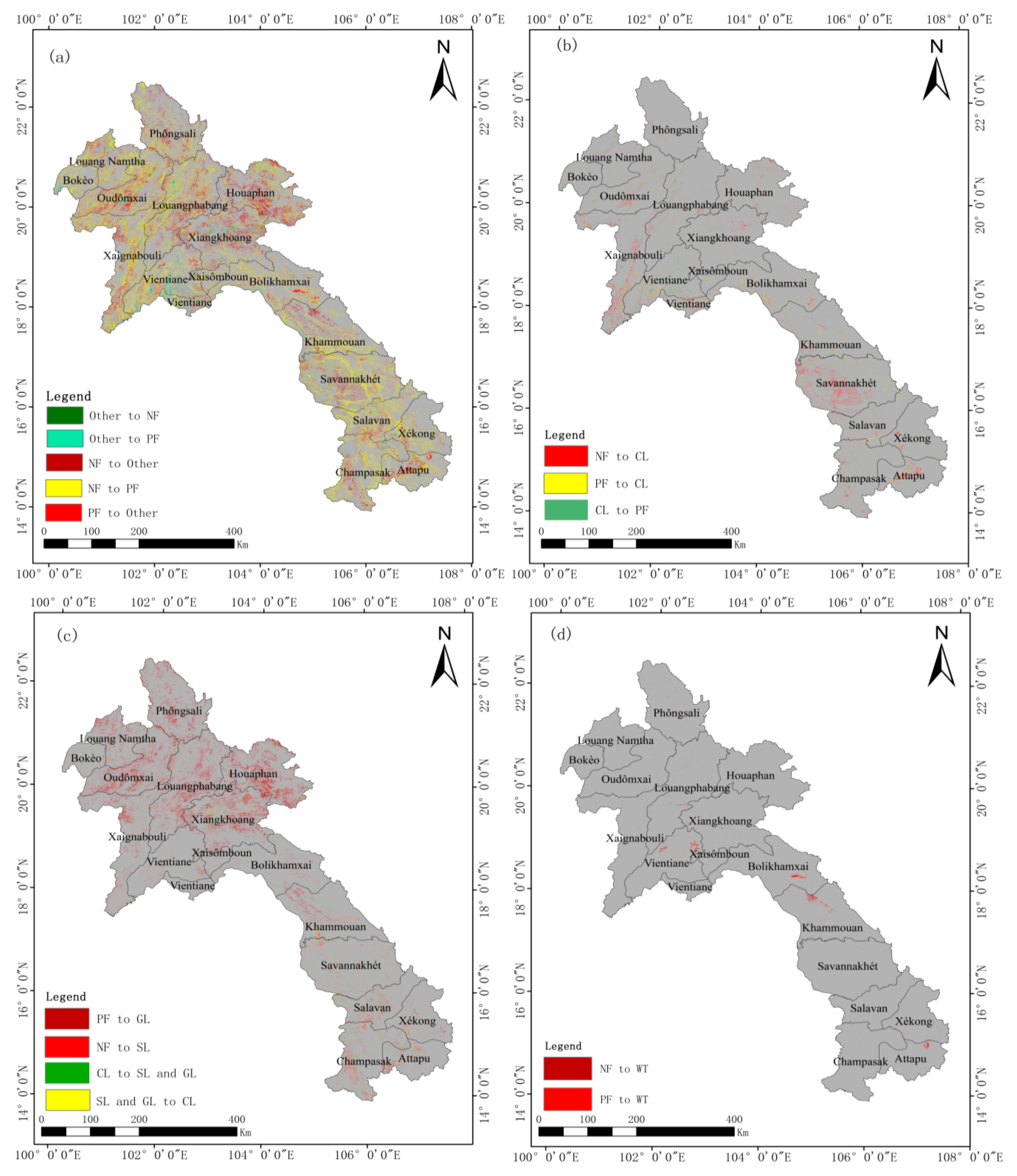
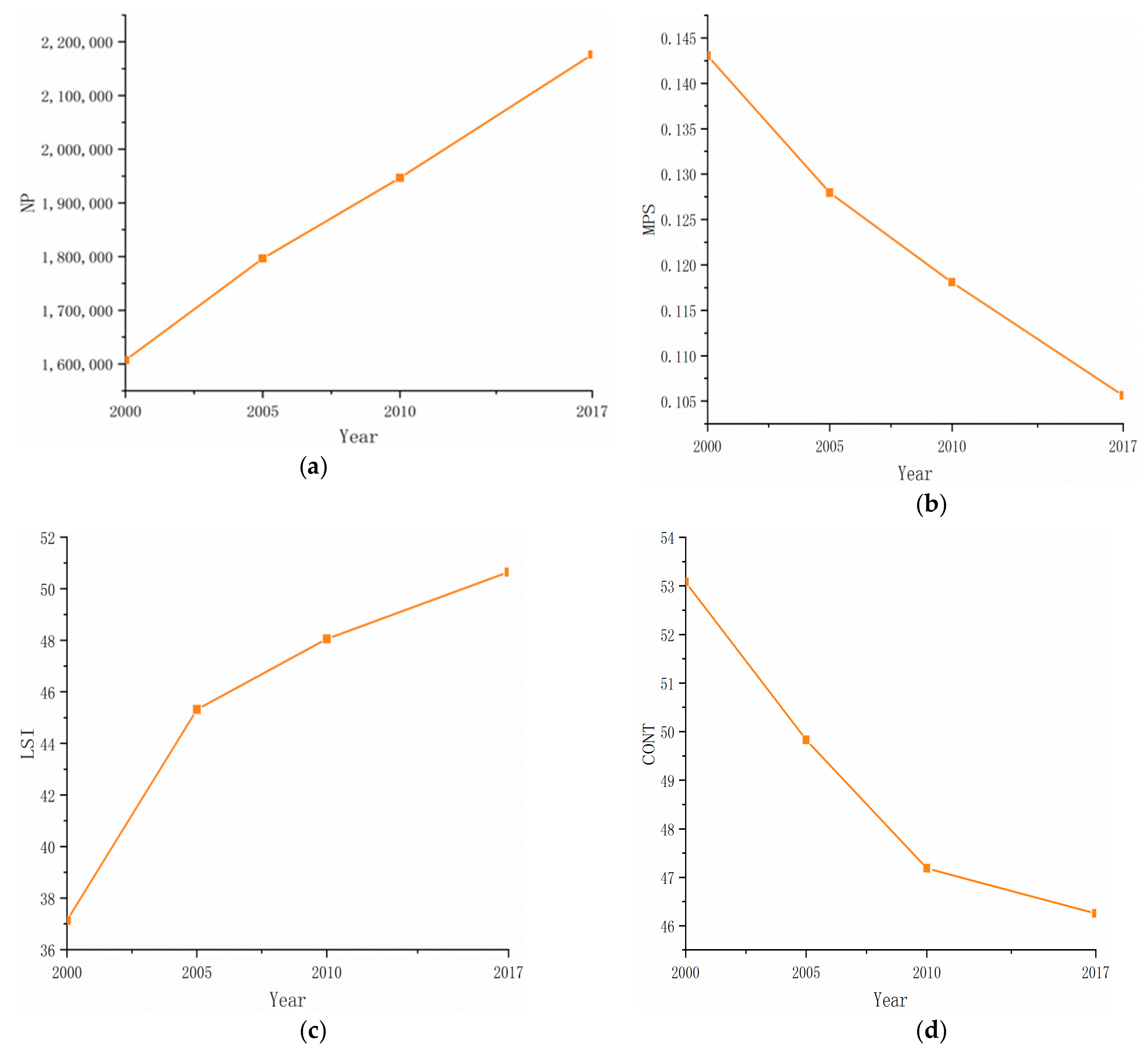

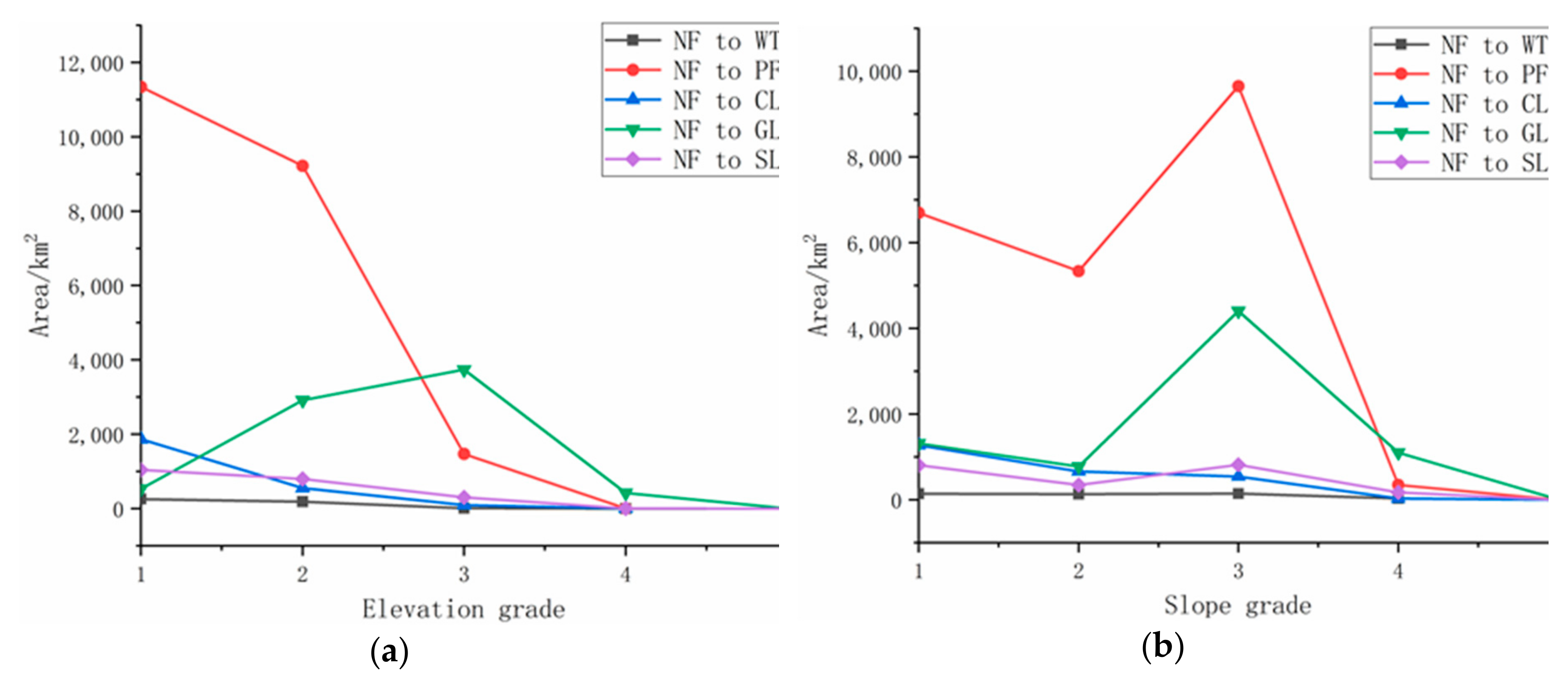
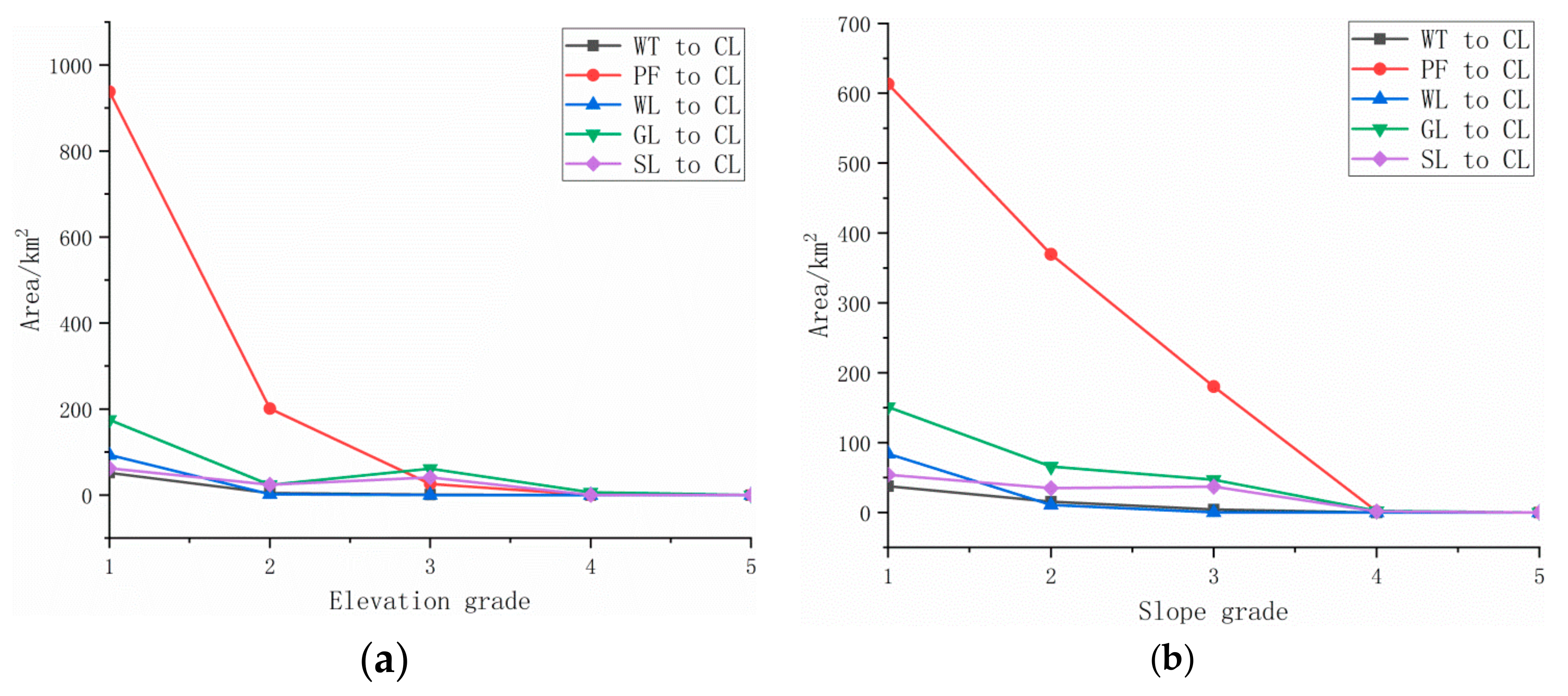
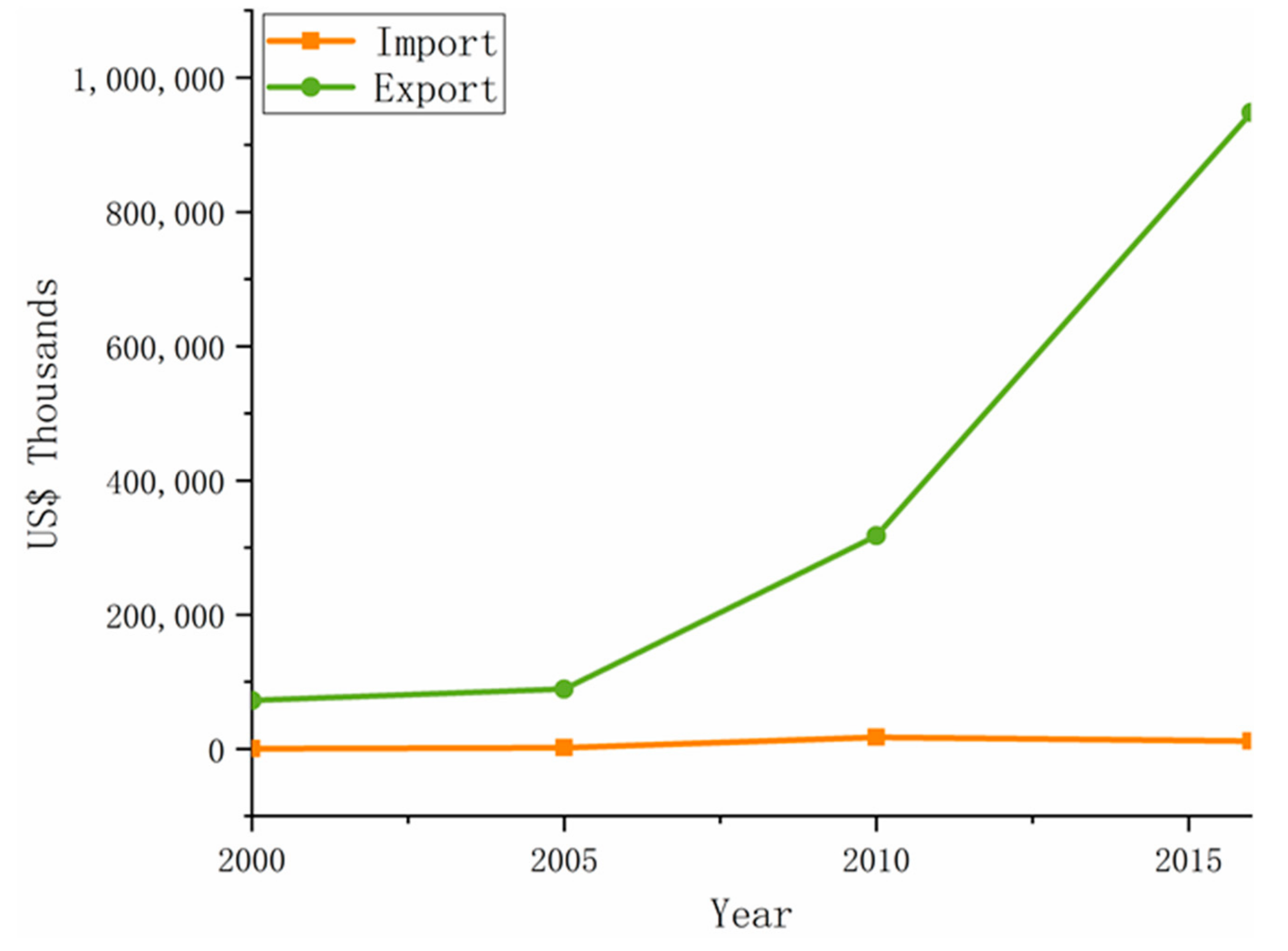
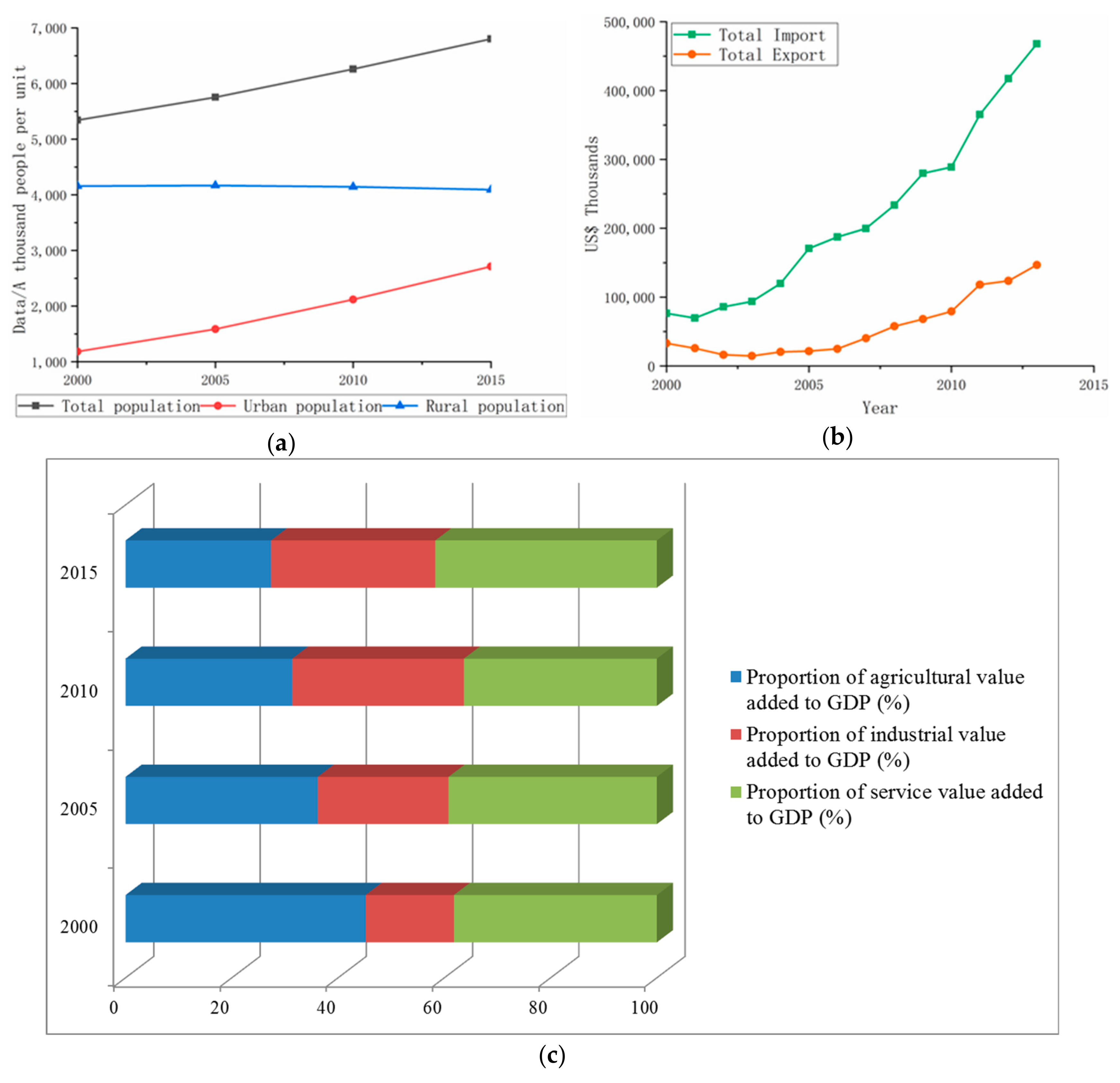
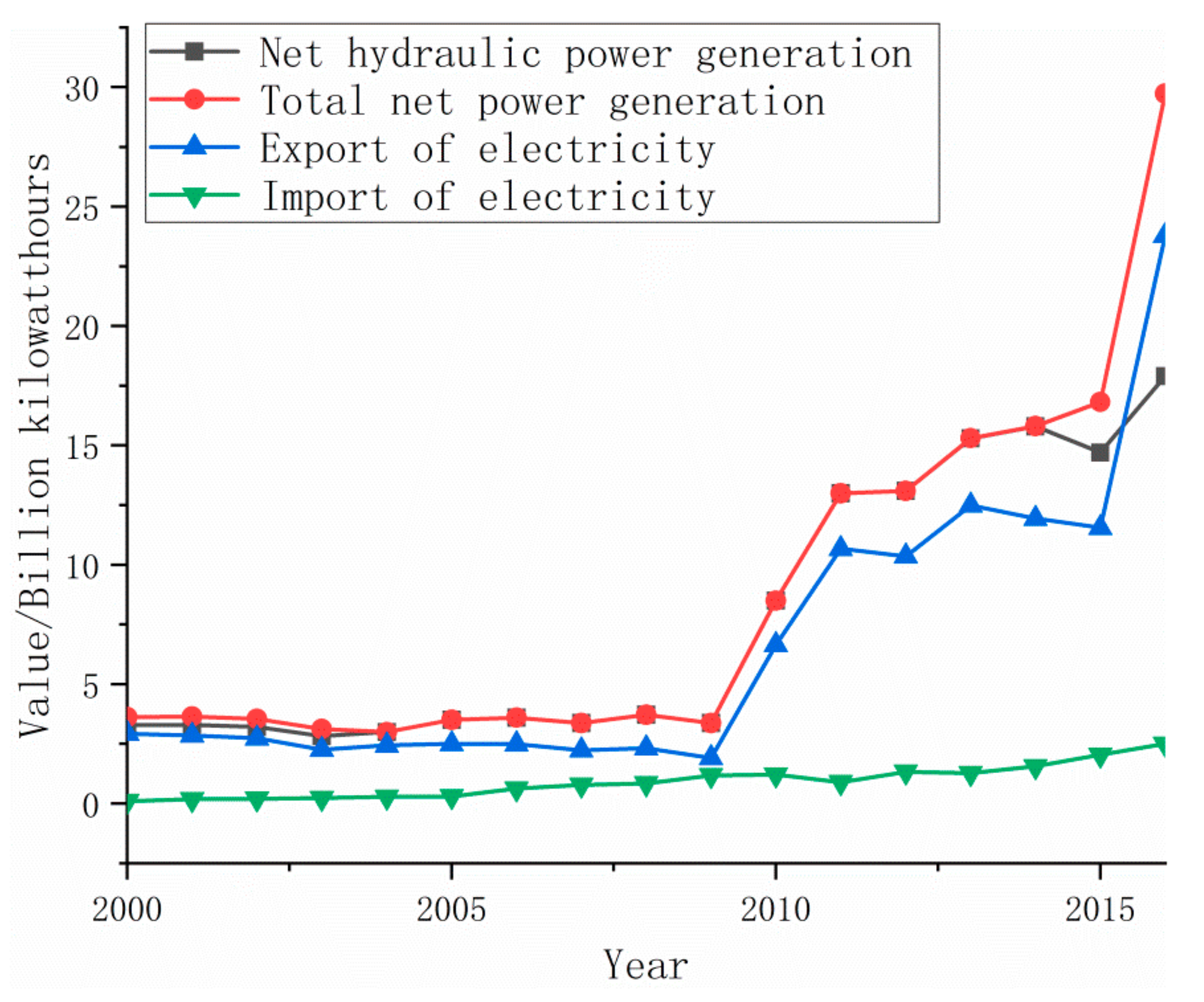
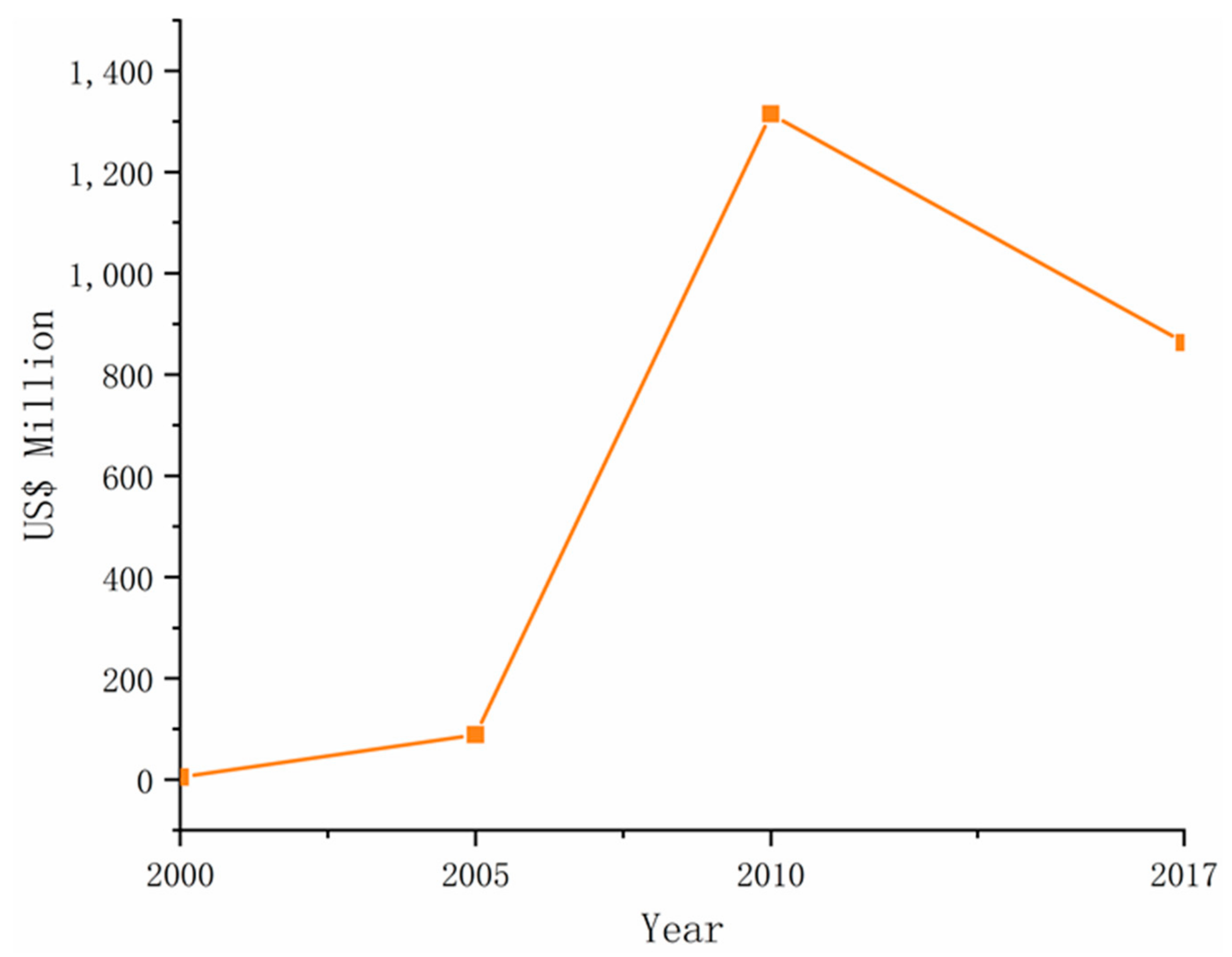
| Code | Servir Mekong 2010 | Merge Type | Abbreviations |
|---|---|---|---|
| 0 | Unknown | - | - |
| 1 | Surface Water | Water | WT |
| 2 | Snow and Ice | - | - |
| 3 | Mangrove | - | - |
| 4 | Flooded Forest | - | - |
| 5 | Deciduous Forest | Natural Forest | NF |
| 6 | Orchard or Plantation Forest | Plantation Forest | PF |
| 7 | Evergreen Broadleaf | Natural Forest | NF |
| 8 | Mixed Forest | Natural Forest | NF |
| 9 | Urban and Built Up | Built Up | BU |
| 10 | Cropland | Cropland | CL |
| 11 | Rice | - | - |
| 12 | Mining | Mining | MI |
| 13 | Barren | Barren | BR |
| 14 | Wetlands | Wetlands | WL |
| 15 | Grassland | Grassland | GL |
| 16 | Shrubland | Shrubland | SL |
| 17 | Aquaculture | Aquaculture | AL |
| Grade | 1 | 2 | 3 | 4 | 5 |
|---|---|---|---|---|---|
| Elevation | <500 m | 500–1000 m | 1000–1500 m | 1500–2000 m | >2000 m |
| Slope | <3° | 3°–10° | 10°–35° | 35°–65° | ≥65° |
| Land Use Class | 2000 | 2005 | 2010 | 2017 | ||||
|---|---|---|---|---|---|---|---|---|
| Area/km2 | Proportion/% | Area/km2 | Proportion/% | Area/km2 | Proportion/% | Area/km2 | Proportion/% | |
| WT | 2903.06 | 1.26 | 2769.79 | 1.20 | 3228.77 | 1.40 | 3434.70 | 1.49 |
| NF | 164,087.51 | 71.40 | 147,753.80 | 64.29 | 140,525.98 | 61.14 | 129,366.03 | 56.29 |
| PF | 34,916.23 | 15.19 | 44,968.45 | 19.57 | 46,972.23 | 20.44 | 56,911.65 | 24.76 |
| BU | 286.57 | 0.12 | 373.44 | 0.16 | 517.42 | 0.23 | 652.53 | 0.28 |
| CL | 21,117.27 | 9.19 | 22,086.52 | 9.61 | 24,938.18 | 10.85 | 23,156.40 | 10.08 |
| MI | 12.18 | 0.01 | 12.31 | 0.01 | 12.40 | 0.01 | 12.41 | 0.01 |
| BR | 21.76 | 0.01 | 28.13 | 0.01 | 36.93 | 0.02 | 58.92 | 0.03 |
| WL | 512.16 | 0.22 | 462.87 | 0.20 | 481.81 | 0.21 | 436.40 | 0.19 |
| GL | 4875.23 | 2.12 | 9481.21 | 4.13 | 10,485.24 | 4.56 | 12,147.91 | 5.29 |
| SL | 1086.80 | 0.47 | 1869.29 | 0.81 | 2580.26 | 1.12 | 3563.05 | 1.55 |
| AL | 7.85 | 0.01 | 20.81 | 0.01 | 47.40 | 0.02 | 86.62 | 0.03 |
| Land Use Type | 2000 | ||||||||||||
|---|---|---|---|---|---|---|---|---|---|---|---|---|---|
| WT | NF | PF | BU | CL | MI | BR | WL | GL | SL | AL | Total | ||
| 2017 | WT | 2686.95 | 451.65 | 224.72 | 0.01 | 35.53 | 0.00 | 0.86 | 31.60 | 1.90 | 1.26 | 0.22 | 3434.70 |
| NF | 1.86 | 129,174.31 | 39.19 | 0.00 | 12.91 | 0.00 | 0.02 | 2.41 | 48.96 | 86.03 | 0.20 | 129,366.03 | |
| PF | 14.15 | 22,037.82 | 32,791.58 | 0.04 | 1517.06 | 0.01 | 0.13 | 43.87 | 379.98 | 126.78 | 0.20 | 56,911.65 | |
| BU | 28.29 | 88.96 | 56.86 | 286.30 | 158.60 | 0.00 | 2.63 | 5.21 | 11.63 | 14.02 | 0.04 | 652.53 | |
| CL | 57.72 | 2517.20 | 1165.28 | 0.02 | 18,921.66 | 0.01 | 4.31 | 95.46 | 266.60 | 127.98 | 0.15 | 23,156.39 | |
| MI | 0.00 | 0.15 | 0.04 | 0.02 | 0.03 | 12.15 | 0.00 | 0.00 | 0.00 | 0.00 | 0.00 | 12.41 | |
| BR | 5.35 | 14.92 | 6.99 | 0.00 | 11.80 | 0.00 | 13.11 | 0.53 | 4.85 | 1.37 | 0.00 | 58.92 | |
| WL | 61.08 | 23.52 | 16.31 | 0.00 | 15.28 | 0.00 | 0.22 | 309.91 | 8.48 | 0.31 | 1.28 | 436.40 | |
| GL | 8.35 | 7607.30 | 285.85 | 0.01 | 113.17 | 0.00 | 0.06 | 1.80 | 3953.28 | 178.09 | 0.02 | 12,147.92 | |
| SL | 12.17 | 2142.62 | 313.87 | 0.00 | 327.43 | 0.00 | 0.39 | 16.48 | 199.27 | 550.80 | 0.02 | 3563.05 | |
| AL | 27.13 | 28.88 | 15.55 | 0.17 | 3.80 | 0.00 | 0.05 | 4.87 | 0.29 | 0.17 | 5.71 | 86.62 | |
| Total | 2903.06 | 164,087.31 | 34,916.22 | 286.57 | 21,117.25 | 12.18 | 21.76 | 512.16 | 4875.23 | 1086.80 | 7.85 | ||
| Change Range | 531.64 | −34,721.28 | 21,995.43 | 365.96 | 2039.14 | 0.23 | 37.16 | −75.76 | 7272.69 | 2476.25 | 78.76 | ||
© 2019 by the authors. Licensee MDPI, Basel, Switzerland. This article is an open access article distributed under the terms and conditions of the Creative Commons Attribution (CC BY) license (http://creativecommons.org/licenses/by/4.0/).
Share and Cite
Wang, J.; Sui, L.; Yang, X.; Wang, Z.; Ge, D.; Kang, J.; Yang, F.; Liu, Y.; Liu, B. Economic Globalization Impacts on the Ecological Environment of Inland Developing Countries: A Case Study of Laos from the Perspective of the Land Use/Cover Change. Sustainability 2019, 11, 3940. https://doi.org/10.3390/su11143940
Wang J, Sui L, Yang X, Wang Z, Ge D, Kang J, Yang F, Liu Y, Liu B. Economic Globalization Impacts on the Ecological Environment of Inland Developing Countries: A Case Study of Laos from the Perspective of the Land Use/Cover Change. Sustainability. 2019; 11(14):3940. https://doi.org/10.3390/su11143940
Chicago/Turabian StyleWang, Jun, Lichun Sui, Xiaomei Yang, Zhihua Wang, Dazhuan Ge, Junmei Kang, Fengshuo Yang, Yueming Liu, and Bin Liu. 2019. "Economic Globalization Impacts on the Ecological Environment of Inland Developing Countries: A Case Study of Laos from the Perspective of the Land Use/Cover Change" Sustainability 11, no. 14: 3940. https://doi.org/10.3390/su11143940
APA StyleWang, J., Sui, L., Yang, X., Wang, Z., Ge, D., Kang, J., Yang, F., Liu, Y., & Liu, B. (2019). Economic Globalization Impacts on the Ecological Environment of Inland Developing Countries: A Case Study of Laos from the Perspective of the Land Use/Cover Change. Sustainability, 11(14), 3940. https://doi.org/10.3390/su11143940









